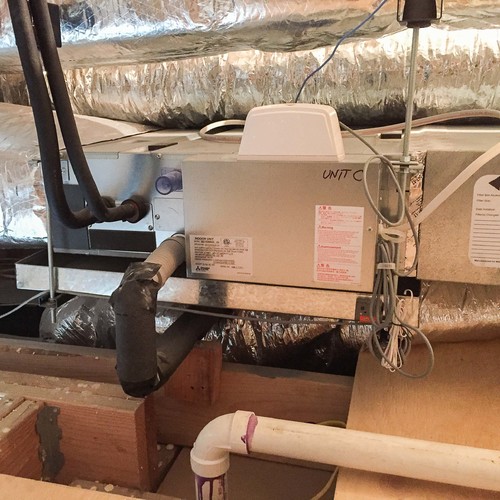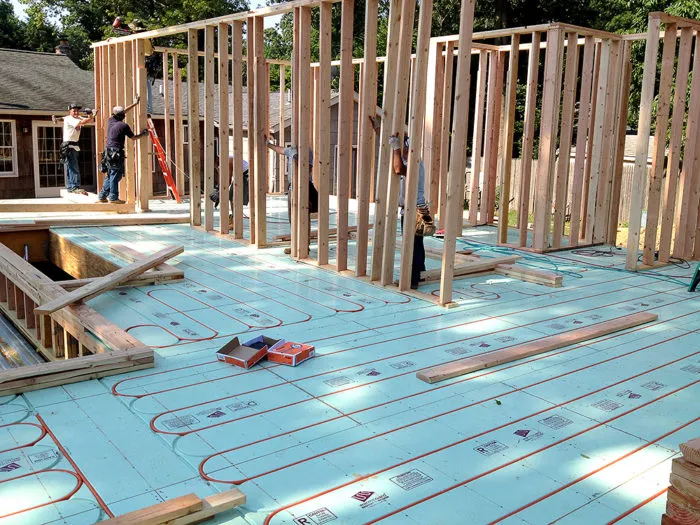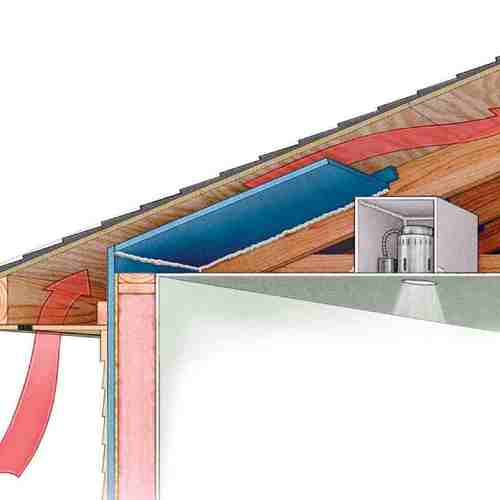
Writing from Washington, D.C., Mara recounts an experience many of us have had: the house fix she spent a lot of time and money on didn’t fix the problem she started with.
In this case, Mara upgraded the insulation in her walk-up (conditioned) attic in hopes of evening out temperature imbalances around the house. The flash-and-batt procedure in the attic included 2 in. of closed-cell polyurethane foam on the bottom of the roof deck and gable-end walls, and then “soooo many hours” of labor to install R-23 mineral wool batts in the non-standard rafter bays.
“We were hoping after thousands of dollars of investment this would solve the problem of it being distinctly colder upstairs than downstairs,” Mara writes in this recent Q&A post. Did it work? “Unfortuntely, no.”
The 1910 duplex has no insulation in the walls. Most of the windows in the house have upgraded storm windows.
Mara keeps the house at 68°F most of the time. The thermostat for the single-zone heating system is located in the dining room, with radiators of various sizes located throughout the house.
In a nutshell, the problem is that room-to-room temperatures are uneven. The first floor stays the warmest, with the second floor a little cooler, and the attic several degrees below that. The pattern is consistent—no matter what the temperature is outdoors.
Mara writes that adding insulation in the basement isn’t feasible. Putting insulation on top of the roof deck is a possibility if she can find the skilled labor to do the work. The stucco exterior makes insulating the walls “not a great idea.”
Mara shares “an eye-glazing amount of data” about the house (read her original post for all of the details). “The reason I’m doing so is I want to learn lessons for…
Weekly Newsletter
Get building science and energy efficiency advice, plus special offers, in your inbox.

This article is only available to GBA Prime Members
Sign up for a free trial and get instant access to this article as well as GBA’s complete library of premium articles and construction details.
Start Free TrialAlready a member? Log in















11 Comments
Bravo to Peter for providing so many good comments on these over the years, helping the questioners and educating everyone in this community.
As for this question, I have two comments. First, I think there is still a puzzle here, in that air leakage generally makes the lower floors cold more than the upper floors. So I would not be ready to jump on that as the problem without investigating more specifically. A thermal camera could be useful even without a blower door. Second, redoing the plumbing of a hydronic system is a lot easier than redoing ductwork. So reconfiguring to allow zoning is a realistic possibility, though not necessarily a cheap one.
Thank you Peter for years of insights and sharing your experience.
This seems an appropriate finale. I think human comfort factors (operative temp, etc.) sometimes doesn't get enough play when considering solutions—or I at least don't always consider it as I should. The point of heating our homes is, after all, for our comfort—not to maintain a set air temperature.
The notion that an under-desk radiant heater might be the 'easiest, least expensive, and most effective way to increase [one's] thermal comfort', is actually quite profound in some ways. And now I know what to get my partner for a newyear's gift. Blankets work too of course, but they can be a hindrance to personal comfort in some cases.
Peter, you could have recorded that conversation from my house on any given morning. When I read it aloud to my wife, she reached your punchline before I could even say it. Thanks very much for all of your insights.
Tyler, the idea of using radiant heaters to warm people is not new. Google "heat people, not buildings" and prepare for a long evening. There's some very interesting work going on in the field. But of course the idea of having a small space heater under the desk is also not a new idea. Personally, I like the idea of messing with the emissivity of wall surfaces just like we do windows to make it "feel" warmer in the room.
Not new, simply profound. Reminds me of the story of Muir sleeping by a fire, turning like a roast on a spit to even his warmth.
Thanks for the search tip; I'm sure to enjoy the rabbit hole.
I can't help but picture living in an apollo command module. Don't forget to stir the O2 tanks.
What a sneaky way to get me to sign up for the premium package, guys! Peter, your number 1 question is quite insightful. We did insulate the attic because we wanted to be kinder to the planet and also be able to keep it warmer without spending a fortune. (Before the attic insulation, we used to let it go down to 55 at night, I think? Now the thermostat is set to 63, but in our bedroom, because of the lack of balance, it can fall to 59 or 61 overnight.
Charlie, we will not replumb the heating system because the comfort issue is not worth spending thousands more. We might consider the thermostatic valve if we could figure out how it could be done and it wasn't too spendy -- if the bleeding/setting boiler temp higher didn't do the trick. Which it may have.
And so far, post-attic insulating, heating has been pretty affordable -- $90 last month, including the hot water heater, 79 therms, for 1300 sq ft plus unfinished attic and basement.
We do have a programmable thermostat, so it warms up to 63 upstairs by the time we get up.
A boiler expert is here now. He said it's too risky to turn the knobs to adjust the radiators because they have been frozen in place for decades. However, they bled all the radiators for us (and the upper radiators did need more bleeding they said) and they are changing the setpoint of the boiler from 160 degrees to 170 degrees.
They claimed bleeding would be enough to even out the temperature.
We will watch the pattern now and see what happens! The radiators do feel much hotter to the touch... I wonder if we should adjust the boiler temperature back down in case we get foster kids age 6 or 7?
With regard to the moisture in the basement, we do now run a dehumidifier and we are getting the ancient not-usually-working sump pump replaced. We also got a rain barrel, which might help with water at the front wall, which is generally the problem area for small puddles or damp floor/wall from time to time with the rain, though it depends on the storm. (We don't get water every time there's a big rain, either.)
We also replaced one piece of plexiglas where a window ought to be with a real window and replaced the basement back door from a non-exterior wooden door to a proper exterior door. So there should be modestly less air intrusion at basement. (Also, when I was putting plastic over one of the remaining old basement windows, I discovered a small hole where frame met wall, so we caulked that up).
The thermometer/hydrogemeter combo units we got do not show that the attic is any more humid than the rest of the house since we insulated at the roof line/ & airsealed the gable walls/soffits. Basically, the hydrometer shows what you would expect. Very high humidity in the summer, unless there's a window unit going (most rooms do not have one), less humidity in fall, very low humidity now.
The blower test/thermal camera work was done just for our half of the duplex (the only half we own), fwiw.
Thanks for all your interest, guys!
Update - seems that bleeding may not have achieved much. Running water temperature hotter may help somewhat both in retarding heat loss after boiler cuts off and while boiler is active, but definitely does not make the temperature differential disappear in the North-facing, more-exterior walls front bedroom. Home office, which is smaller/sunnier/less exposed to exterior seems to match downstairs temperature more often, at least on this sunny day.
Temperature of radiators does not seem dangerously hot as long as you don't run the boiler to try and reach 74 degrees (as the plumbers did).
Too bad the bleeding didn't help more but hopefully it helped a little.
My rain barrel tends to catch most of the runoff from small storms but to help less with the heavy rains because it's full after only a little of the storm. Most important is to route the overflow from it well away from the foundation.
My first step in any energy project is to understand the problem before spending money on improvements. This is the right time of year to do infrared thermography and air leakage testing. This process can include prioritizing any defects so you can start with the worst problems and work your way toward the smaller defects until you are satisfied with the results. Most utilities have low or no-cost energy reduction services that are aimed at reducing peak loads. Contact information for these weatherization programs are listed on your electric bill. Their reports will usually give you the information you need to figure this problem out. If not, contact an energy consultant. It may cost a few dollars, but you won't waste money on repairs/improvements that were not at the top of a well-targeted priority list.
Dear Hcftesla123,
Oh, we did spend a couple hundred dollars on an energy consultant before we ever did this project, as Pepco does not offer free energy audits. They were not very helpful, as is noted in the article -- did not write up a report, did not give a CFM number, they mostly wanted to sell their version of attic insulation.
We do not really contribute to peak loads of the electric company since we have no central air and only use a window a/c a handful of nights a year. :)
1910duplex, I so admire your tenacity! You have done a lot of important work to reduce your energy usage and to improve your living space. I also feel your pain, having lived with a fussy house. I have three pretty simple thoughts, that might help, assuming you have not already done them.
The first look for every tiny leak you can. Arm yourself with some cans of foam spray (windows and doors, gaps and cracks), some electrical box insulation (if you have not done this), and a BLACK+DECKER Thermal Leak Detector (TLD100) (~$35). The grand kids call it my ray gun. Walk around your house and "test the rays". Turn the lights off and look at the temperatures around all your doors and windows, as well as the walls. If you have a cold spot on the wall, perhaps some insulation near by can help.
Take your time and make several trips. Chances are you can make a lot of positive changes on your own time frame, without dragging in a bunch of workers in these Covid times. If you have the tools, a tiny wrecking bar and a battery-powered finish nailer lets you remove trim, foam, and replace the trim. If you don't have a finish nailer, given the age of the house, you may actually do fine with finish nails. The foam will effectively act as an adhesive for the trim once it cures so you won't need a lot of nails.
Second, and on the totally not-building-science side, consider using wall art if you have cold spots. It won't help with the room temperature, per se, but it can help with the mean radiant temperature and perceived comfort. Examine your wall's cold spot and imagine wall art for it. Put something you like in the frame and then use 1/2 to 1" foam board as a backer on the frame and then cover the cold spot. There was a reason they put large tapestries on castle walls!
Even if you don't solve the heat equalibration problem, you will be more comfortable in individual rooms.
Third, as you noted in your post, you might decide you actually don't care that the temperature is the same from floor to floor. One very wise HVAC person who worked on our old house recommended that we heat the whole house to a minimum safe (for pipes, people, and wood furniture) temperature and then heat the space where we were for the comfort of the individuals in that space for the time they occupy the space. It changed the entire way we thought about heating our home. Of course, going from the den where we were snugged in with tiny LED fireplace to the hall was like going outside but it did improve our comfort and reduce our power usage.
Good luck and thank you for trying to preserve a piece of architectural history and the planet simultaneously.
I've dealt with such a similar problem in my 1905 mid hudson valley house, zone 6A. After having solved this issue I would look at it from two points of view.
First the hydronic heating system. Are the radiators on the top floor getting hot enough? Like has been previously mentioned the water temperature setpoint should be in the 180 degree range for this type of system. But its also important the the circulation pump is up to the task and the radiators are expelling enough heat, or getting enough hot water. Checking the radiator temperature and the return temperature of the water to the boiler can help diagnose this. Not knowing the configuration of the system in the house in question its hard to point out potential problems but despite the energy loss in the house its good to know that you're getting the BTUs to the parts of the house that need the heat. Bleeding and balancing the radiators as has previously mentioned can help this process. When I bought my house a decade ago the boiler was bad so I installed a modulating condensing boiler but it allows setpoint of 180 degrees so the radiators are warm. The lachinvar unit has temperature sensors and really only modulates in the shoulder seasons so I'm not seeing the total benefit of this type of appliance but it was worth it over replacing with a conventional unit. Balancing the valves on the radiators made a big difference but using a programmable thermostat was still useless because the recovery time was sooooo long. That brings us to heat loss.
If you know you're heating the whole house then focus on the energy loss. In my house I added insulation to the attic as you did. I found and sealed multiple penetrations in the attic, mostly from electrical wiring. Years later I went back and paid special attention to anything on an exterior wall as this house is balloon construction. I didn't see any mention of that in the original post. I also added R38 bats across the attic floor. This made a difference in comfort and total energy use but the exterior walls were still very cold and different rooms felt different temperatures. Windows were all replaced mostly because half of them didn't work (were caulked or painted shut). That made nearly no difference in the energy or comfort but the house looks much better without storm windows and all the windows now operate. Finally I made my way to the basement, where like the original poster I had a damp basement and it was leaky with air. Changes in the gutter system and moving the water away from the house made a huge difference. I too had a rain barrel and didn't pay attention to what happened to the water when that barrel overfills, turns out it ended up in my basement. That is now gone, gutters are fixed. Plastic over the crawl space (only part of the house), sump pump cleaned out and fitted with a sealed sump cover (though once the gutters were fixed the sump is always dry). Then I found the big issue, air leaks at the sill and rim/band joists. Turns out those air leaks were getting right into the balloon walls and making a chimney of cold air. Borate treatment to prevent pests and closed cell foam on the rim/band/sill changed the whole house. I too have no insulation in the exterior walls on a stucco house. Air sealing the basement increased the exterior wall temperature significantly as well as the comfort in the whole house. Now the basement is dry and not drafty.
The basement was only done last year and after such a significant change I upgraded the HVAC system with a ductless air source heat pump with ceiling cassettes for the second story and removed the radiators. That has worked out great so far this winter and allows individual room zoning and better places to put furniture. The old hydroonic system still heats the first floor and the baths with traditional cast iron radiators. After chasing this issue for a decade I finally have the most comfortable winter I've ever had in this house, just in time for a pandemic winter at home.
Peter said "The building science cardinal rule is to honor the unavoidable relationship between heat and moisture flows. That means:
Manage moisture first.
Manage air leaks second.
Insulate third."
Wish I had read that a decade ago, I would have been comfortable long ago.
Log in or become a member to post a comment.
Sign up Log in